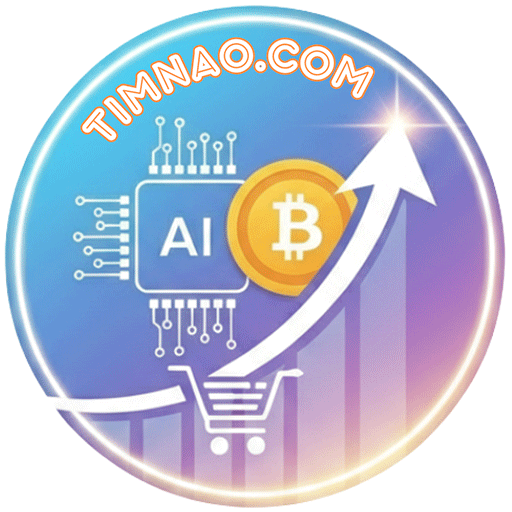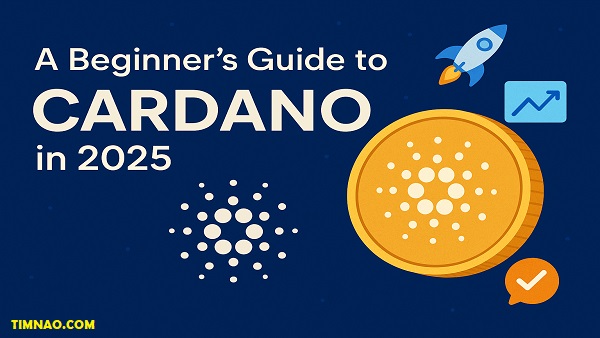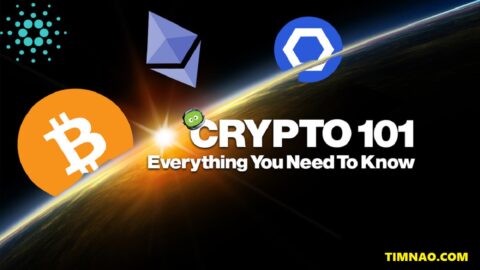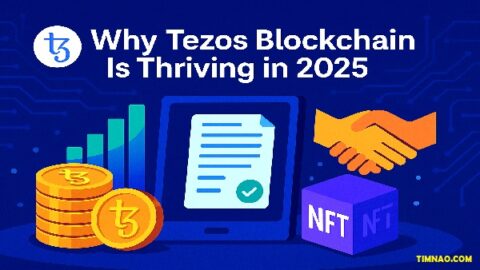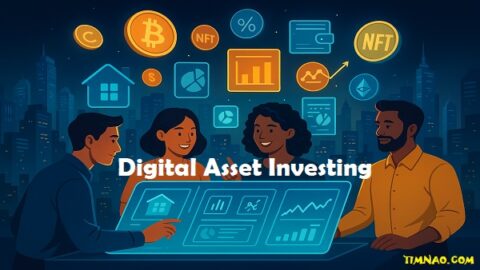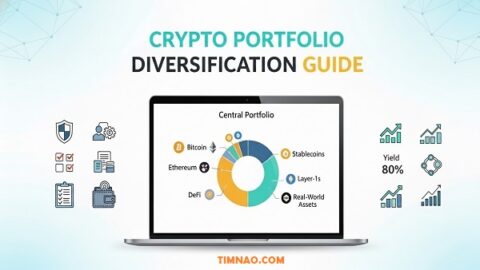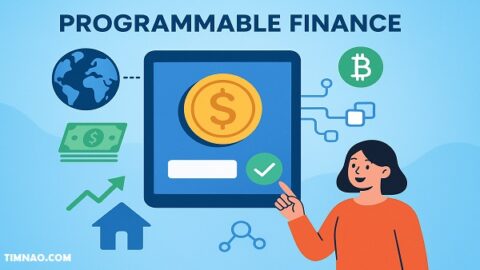🚨 Why Cardano Is Dominating the Crypto Future: A Beginner’s Guide to ADA Power 💥
Cardano beginner guide – If you’re just starting your crypto journey and looking for a platform that’s secure, scalable, and packed with real-world potential, Cardano might be your perfect entry point. In a world flooded with blockchain hype, Cardano stands out by doing things differently—focusing on academic research, energy efficiency, and long-term growth. Powered by its native token ADA, Cardano has quietly become a major force in decentralized finance (DeFi), smart contracts, and green blockchain innovation.
Whether you’re curious about how staking works, how to buy and store ADA, or why Cardano’s governance model gives real power to the people, this guide is for you. We’ve broken down everything a beginner needs to know in 2025—no jargon, just clear, actionable steps to help you get involved, invest smartly, and understand the real value behind Cardano’s rise.
Let’s dive in 👇
📚 Table of Contents
- 🚀 What Is Cardano and Why It Matters in 2025
- 🪙 ADA Explained: More Than Just a Cryptocurrency
- 🏗️ How Cardano’s Technology Stands Out
- ⚙️ Smart Contracts Made Simple
- 💸 The DeFi Revolution on Cardano
- 🧠 Governance: Giving Power to the People
- ♻️ Proof of Stake: How Cardano Stays Green and Secure
- 🆚 Cardano vs Other Blockchains: Who’s Winning?
- 🔮 The Future of Cardano: What’s Next?
- 🧰 Getting Started with Cardano: Wallets, Staking & Safety Tips
- 🎯 Final Thoughts: Is Cardano Right for You?
- ❓ FAQs for Crypto Newbies
🚀 What Is Cardano and Why It Matters in 2025
Cardano beginner guide wouldn’t be complete without explaining what makes Cardano such a standout in the crypto universe—especially now in 2025.
Cardano is more than a digital currency. It’s a next-generation blockchain platform designed to solve real problems that Bitcoin and Ethereum are still grappling with: high energy consumption, network congestion, slow transactions, and centralized control.
Launched in 2017 by Charles Hoskinson, a co-founder of Ethereum, Cardano was built from the ground up on peer-reviewed research and scientific principles. That means every feature is based on academic rigor, not hype.
What sets Cardano apart?
🌐 1. Layered Architecture
Cardano’s blockchain is split into two layers:
- Settlement Layer (CSL) – Handles ADA transactions
- Computation Layer (CCL) – Runs smart contracts and dApps
This separation boosts scalability and flexibility, making Cardano future-proof.
🔒 2. Energy-Efficient Proof of Stake
Instead of relying on power-hungry mining, Cardano uses the Ouroboros proof-of-stake protocol, which allows users to validate transactions by staking their ADA. This approach is:
- ✅ Environmentally friendly
- ✅ Community-inclusive
- ✅ More cost-effective than proof-of-work models
🌍 3. Built for Global Inclusion
Cardano isn’t just targeting Wall Street investors or NFT flippers. Its vision is financial inclusion, especially in underbanked regions.
As of 2025, Cardano has active partnerships across Africa (notably Ethiopia and Ghana), where it powers digital identity and education platforms using blockchain.
🔄 4. Ready for Real-World Use
With support for smart contracts, NFTs, and decentralized finance (DeFi), Cardano is no longer “potential tech.” It’s actively used in real ecosystems, including:
- Education verification tools
- DeFi platforms like Minswap
- NFT marketplaces and identity management tools
- Global initiatives like World Mobile
💬 In short: Cardano is the blockchain that’s serious about real-world utility, long-term sustainability, and inclusive governance.
🪙 ADA Explained: More Than Just a Cryptocurrency
Cardano’s native token, ADA, plays a central role in making this ecosystem work. But unlike many crypto coins that exist purely for speculation, ADA is a utility powerhouse.
Here’s what beginners need to know in 2025:
💸 1. It’s a Currency—But So Much More
You can use ADA to:
- Transfer value globally
- Pay for services or goods (especially in Web3 environments)
- Interact with decentralized applications (dApps)
- Provide collateral in DeFi lending/borrowing platforms
- Stake to earn rewards and secure the network
- Vote in on-chain governance decisions
In essence, ADA is your all-access pass to the Cardano ecosystem.
💰 2. Staking = Passive Income
Unlike traditional savings accounts, ADA holders can earn 3%–5% annual rewards simply by staking. No need for technical setup—you just delegate your tokens using a wallet like Yoroi or Lace.
This model encourages long-term holding and network security—a win-win for users and the blockchain itself.
Fun fact: As of early 2025, over 75% of ADA in circulation is actively staked, making it one of the most decentralized and secure blockchain networks globally.
🧠 3. ADA Is Governance-Ready
With every ADA you hold, you gain voting power in Cardano’s evolving governance model. This means you can participate in major decisions about the platform’s direction—like protocol upgrades, development grants, and treasury use.
The Project Catalyst initiative lets users propose and vote on real-world projects that receive funding directly from Cardano’s on-chain treasury.
🔄 4. ADA Powers a Thriving DeFi Scene
As the backbone of Cardano-based DeFi apps, ADA fuels everything from:
- Yield farming
- Token swaps
- Liquidity provision
- Decentralized stablecoins like DJED
ADA’s versatility makes it a core asset for DeFi while still retaining its role as a digital currency and governance token.
🏗️ How Cardano’s Technology Stands Out
At a glance, many blockchains seem similar—but dig deeper and you’ll find that Cardano’s technology is fundamentally different. It’s not just another crypto project. It’s a platform engineered with academic precision, environmental responsibility, and future-proof design.
Let’s break down why Cardano’s tech architecture is setting new standards in 2025.
🧱 A Layered Blockchain: Flexibility Built-In
Cardano separates its blockchain into two layers:
- Settlement Layer (CSL): Handles ADA transactions, ensuring fast and secure movement of digital assets.
- Computation Layer (CCL): Executes smart contracts and decentralized applications (dApps) without interfering with the core transaction layer.
🔄 Why this matters: Most blockchains merge both layers, making upgrades complex and risky. Cardano’s separation allows faster scaling, easier updates, and more secure innovation.
⚙️ Ouroboros: A Scientific Breakthrough in Blockchain
Instead of mining (like Bitcoin), Cardano uses Ouroboros, a next-gen Proof-of-Stake (PoS) consensus protocol. It’s the first blockchain protocol based on peer-reviewed scientific research, and it continues to evolve through active academic development.
Key advantages of Ouroboros:
- 🔋 Ultra energy-efficient (uses <0.01% of Bitcoin’s power)
- 📅 Time-structured (epochs and slots) for predictability and reliability
- 🛡️ Highly secure with mathematically proven resistance to attacks
💡 In 2025, Ouroboros is being enhanced with “Ouroboros Leios,” a version that supports high-speed parallel processing of transactions and smart contracts.
🌐 Extended UTXO (EUTXO) Model
Unlike Ethereum’s account-based model, Cardano uses an Extended Unspent Transaction Output model, similar to Bitcoin—but with smart contract compatibility.
Benefits:
- 🧮 Greater predictability in how transactions execute
- 🔐 Higher security for smart contracts
- 💰 Better control over multi-asset transactions
In short, this model gives developers more precision and fewer bugs, which is critical in financial and enterprise applications.
🧪 Research-Driven Development
Every upgrade on Cardano goes through formal verification—a process where code is mathematically tested to ensure it’s free of errors. This is why governments, educational institutions, and enterprises trust Cardano for mission-critical solutions.
📘 Over 150 peer-reviewed papers have influenced Cardano’s core design—something no other blockchain can claim at this scale.
⚙️ Smart Contracts Made Simple
Smart contracts may sound intimidating, but in the world of Cardano, they’re becoming more secure, accessible, and powerful than ever before. As of 2025, Cardano is finally delivering on its long-promised smart contract ecosystem—and it’s doing it better.
🧠 What Is a Smart Contract?
At its core, a smart contract is a self-executing program stored on a blockchain. It automatically performs actions when specific conditions are met—no lawyers, no middlemen, no delays.
Example: You send ADA to a DeFi app, and it automatically lends it out, collects interest, and sends rewards back to your wallet—all governed by code.
💡 Why Cardano’s Smart Contracts Are Different
Cardano uses a custom smart contract language called Plutus, which is based on the Haskell programming language.
Benefits of Plutus:
- ✅ Formal verification – Code is mathematically tested before going live
- ✅ Reduced bugs and exploits – Less risk of hacks, a major problem in Ethereum-based DeFi
- ✅ Modular and reusable code – Developers can build faster and smarter
Cardano also supports Marlowe, a domain-specific language for non-developers—particularly useful in finance, allowing analysts or businesses to build contracts with minimal coding.
⚙️ How Smart Contracts Work on Cardano (in simple terms)
- A developer writes a contract using Plutus
- It gets tested using formal verification tools
- Once deployed, the contract lives on the Cardano blockchain
- Users interact via dApps—automatically triggering the contract logic
This structure makes Cardano ideal for industries where accuracy, transparency, and immutability are non-negotiable, like:
- 💳 Finance (lending, trading, insurance)
- 📦 Supply chains (tracking authenticity and delivery conditions)
- 🏥 Healthcare (verifying patient records)
- 🧾 Legal agreements (automated document execution)
🔍 2025 Smart Contract Ecosystem Highlights
Here are some real examples of smart contract projects on Cardano:
- Book.io – Tokenized eBooks with on-chain ownership and resale
- Liqwid Finance – Lending and borrowing platform powered by ADA smart contracts
- Empowa – Real estate financing for affordable housing in Africa
- Indigo Protocol – Synthetic assets and stablecoin trading
These platforms are not only functional—they’re audited, community-supported, and deeply integrated with ADA’s core utilities.
💸 The DeFi Revolution on Cardano
If you’ve ever dreamed of borrowing, lending, or earning passive income without banks or credit checks, DeFi (Decentralized Finance) is where that dream becomes reality—and Cardano is becoming a serious contender in this space.
By leveraging smart contracts and its powerful ADA token, Cardano’s DeFi ecosystem exploded in 2024 and continues growing rapidly in 2025. What once required a centralized bank or a broker can now be done directly, securely, and transparently using blockchain.
🔍 What Makes DeFi on Cardano Different?
Most DeFi platforms run on Ethereum, but Cardano is carving a unique path by focusing on:
- 🧠 Smart contract security through formal verification
- 🔐 Lower gas fees thanks to its energy-efficient architecture
- 🌎 Global inclusivity, especially in underserved regions
- 💻 Modular design, making DeFi apps scalable and upgradable
💡 In 2025, Cardano ranks among the top 5 blockchain ecosystems for total value locked (TVL) in DeFi, driven by a surge in new users and stablecoin integrations.
🏦 Key DeFi Use Cases on Cardano
1. Lending & Borrowing
Platforms like Liqwid Finance let users lend ADA or other tokens and earn interest. Borrowers can access liquidity by using their crypto as collateral.
- 📈 Passive income through interest
- 🔄 No need to sell your assets to access funds
2. Stablecoins & Synthetic Assets
Cardano supports native stablecoins like:
- DJED – Algorithmic stablecoin backed by ADA and SHEN
- Indigo Protocol – Trade synthetic assets like iBTC (synthetic Bitcoin)
These tools give users exposure to different markets without leaving the Cardano ecosystem.
3. Decentralized Exchanges (DEXs)
Trade tokens directly on platforms like:
No KYC, no third parties—just peer-to-peer swapping powered by smart contracts.
4. Yield Farming & Liquidity Mining
Provide liquidity to DEXs and earn rewards—often in ADA or native tokens like MIN or SUNDAE.
🧠 Beginner tip: Always research “impermanent loss” and platform security before jumping into yield farming.
🔮 The Road Ahead: What’s Coming in 2025
- 🔁 Cross-chain DeFi bridges with Ethereum and Bitcoin
- 📊 Real-time analytics tools for yield optimization
- 🛠️ Better developer tooling to launch dApps faster
- 🏘️ DeFi for Real World Assets – like tokenized housing, commodities, and more
As DeFi grows on Cardano, so does the opportunity for beginners to earn, invest, and take control of their financial future—without relying on banks.
🧠 Governance: Giving Power to the People
Unlike traditional financial or tech systems where decisions are made behind closed doors, Cardano puts its future in the hands of its users. Literally.
Through its unique on-chain governance model, anyone holding ADA can propose, vote on, or influence changes in the ecosystem—like funding community projects, deciding on upgrades, or allocating treasury funds.
This isn’t just a concept—it’s fully live and working as of 2025.
🗳️ Introducing Project Catalyst
Project Catalyst is Cardano’s decentralized innovation fund. It allows ADA holders to:
- 📝 Submit proposals for funding (dApps, tools, education projects)
- 🗳️ Vote on which proposals should receive funds
- 💸 Access a multi-million-dollar treasury funded by blockchain transaction fees
In 2024 alone, Project Catalyst funded over 300 community proposals, ranging from DeFi tools to NFT marketplaces to educational initiatives in Africa and Southeast Asia.
💼 Treasury System: Sustainable and Transparent
Cardano’s treasury system is designed to be long-term, self-sustaining, and democratic. A portion of every transaction fee goes into a community fund, which is reinvested into the ecosystem through a voting process.
Every ADA holder becomes:
- 🔐 A stakeholder
- 🧑⚖️ A decision-maker
- 💡 A contributor to the platform’s evolution
🔁 Continuous Feedback Loop
Governance on Cardano isn’t a one-time vote—it’s ongoing and dynamic. As the ecosystem evolves, so do the governance tools.
Upcoming 2025 governance upgrades include:
- 📱 Mobile-based voting with biometric authentication
- 📊 Real-time dashboards for proposal tracking and impact measurement
- 🤝 DAO integration for collective decision-making in dApps
💬 Why This Matters for Beginners
- 🧠 You’re not just a user—you’re a co-creator
- 🔄 No waiting for CEOs or developers—you vote, things happen
- 🌍 Community-led projects reflect real needs and global diversity
In a world where many blockchain projects operate like tech monopolies, Cardano stands apart by staying true to its founding principle: empowering the many, not the few.
♻️ Proof of Stake: How Cardano Stays Green and Secure
The cryptocurrency space has often faced criticism for its environmental impact, especially proof-of-work blockchains like Bitcoin and early Ethereum. But Cardano is rewriting the story by proving that decentralization doesn’t have to come at the planet’s expense.
Thanks to its Proof-of-Stake (PoS) protocol, Cardano delivers security, decentralization, and sustainability—without guzzling electricity.
🔋 What Is Proof of Stake (PoS)?
Instead of using massive amounts of computing power to solve cryptographic puzzles (as in Bitcoin), PoS selects validators based on how much ADA they “stake”—meaning how much they temporarily lock up to support the network.
- 🏦 The more ADA you stake, the higher your chances of being selected to validate transactions
- 🎁 Validators are rewarded with newly minted ADA and transaction fees
- 🛡️ The system is designed to discourage fraud—bad actors lose their stake if caught manipulating
Cardano’s version of PoS is called Ouroboros, and it’s the first academically peer-reviewed PoS algorithm in crypto history.
🌱 Why It’s Environmentally Friendly
- ♻️ Energy-Efficient by Design: Cardano consumes just 0.01% of the energy that Bitcoin does
- 🧑🤝🧑 No Mining Hardware Needed: Anyone with ADA can stake using a laptop or smartphone
- 🌍 Truly Green Blockchain: In 2025, Cardano continues to rank as one of the world’s most sustainable blockchains
According to recent reports from the Cardano Foundation, running the global Cardano network consumes roughly the same energy as a small town, compared to the entire country-level consumption of Bitcoin.
🌟 Beginner Tip: You don’t need to be a validator to participate—you can simply delegate your ADA to a staking pool and earn rewards passively.
🔐 Security and Participation
- ✅ Over 75% of ADA is currently staked—showing high trust and participation
- 🔐 Decentralized across thousands of stake pools
- 🧱 Resistant to 51% attacks due to economic disincentives built into Ouroboros
In short, Cardano’s PoS doesn’t just reduce energy use—it’s also one of the most secure and community-driven consensus models in crypto today.
🆚 Cardano vs Other Blockchains: Who’s Winning?
There’s no shortage of competition in the blockchain world. From Ethereum to Solana, each network promises fast transactions, smart contracts, and dApps. But when it comes to sustainability, governance, and real-world adoption, Cardano stands in a league of its own.
Let’s compare how Cardano stacks up in 2025:
| Feature | Cardano (ADA) | Ethereum (ETH) | Solana (SOL) |
|---|---|---|---|
| Consensus | Proof of Stake (Ouroboros) | Proof of Stake (Casper) | Proof of History + PoS |
| Energy Efficiency | ✅ Ultra-low | ✅ Moderate | ⚠️ Moderate |
| Transaction Speed | 🚀 Moderate but stable | ⚡ Faster with L2s | ⚡⚡ Extremely fast |
| Network Downtime | ✅ Extremely rare | ⚠️ Occasional L2 issues | ❌ Frequent outages in 2023–2024 |
| Smart Contract Security | ✅ Formally verified | ⚠️ Higher risk of exploits | ❌ Past vulnerabilities |
| Governance | 🗳️ On-chain, community-led | 🛑 Mostly dev-controlled | ❌ Centralized validators |
| DeFi Ecosystem Growth (2025) | 📈 Accelerating | 🔝 Mature but congested | ⚡ Niche focus on NFTs/gaming |
| Real-World Impact | 🌍 Active in Africa, education, ID | 🌐 Broad enterprise adoption | 🎮 Strong in gaming and NFTs |
🧠 Key Takeaways
- Cardano vs Ethereum: While Ethereum remains the dominant smart contract platform, its high gas fees and dependence on Layer 2 scaling solutions create friction. Cardano offers low fees, native scalability, and stronger security for mission-critical apps.
- Cardano vs Solana: Solana is lightning-fast but has suffered from multiple outages and centralization concerns. Cardano trades raw speed for stability, decentralization, and long-term trust.
- Governance Advantage: Most blockchains leave decisions to developers or foundations. Cardano empowers every ADA holder to help shape the future—a rare and powerful feature in today’s Web3 space.
📌 In 2025, Cardano isn’t the loudest or the flashiest—but it’s proving to be the most durable, equitable, and future-ready.
🔮 The Future of Cardano: What’s Next?
As we enter the second half of the decade, Cardano isn’t just catching up—it’s paving its own path with innovations that blend governance, scalability, privacy, and real-world adoption. If you’re looking to invest time or capital in a blockchain that’s thinking long-term, Cardano’s 2025 roadmap is one to watch closely.
🗺️ The Voltaire Era: Full On-Chain Governance
Cardano is currently transitioning into the Voltaire era, the final phase of its original roadmap. This will bring:
- 🗳️ Self-governance, where ADA holders make decisions without any centralized foundation
- 🧾 Constitution drafting by the community to define Cardano’s core principles
- 🛠️ Protocol upgrades by vote, giving users full control over the network’s evolution
🔥 In 2025, Cardano will become one of the first fully decentralized blockchains where governance is handled 100% on-chain—by the people, for the people.
🌉 Interoperability with Other Chains
Cardano is also working on seamless integration with:
- 🔁 Bitcoin and Ethereum via sidechains and bridges
- 🌌 Cosmos and Polkadot ecosystems using cross-chain communication tools
- 🧠 AI & privacy chains like Midnight, Cardano’s own privacy-focused protocol
These integrations will allow ADA to move freely across networks while preserving Cardano’s core values of security and decentralization.
🪙 RealFi: Bridging DeFi with Real-World Use
The RealFi initiative is about bringing DeFi tools to the real world, particularly in developing regions. Examples include:
- 🏠 Microloans for housing via Empowa
- 📚 Education credentialing and identity verification in Ethiopia
- 💳 Mobile crypto banking for the unbanked through World Mobile
Cardano is not just a platform for speculation—it’s becoming infrastructure for a fairer global economy.
🧠 AI & ZK-Tech Integration
In 2025, Cardano is exploring the integration of:
- 🤖 AI-powered auditing for smart contracts
- 🕵️ Zero-Knowledge (ZK) privacy features via Midnight
- 🔒 Confidential smart contracts with off-chain data interactions
These advances will allow more sensitive industries (like healthcare, legal, and enterprise) to build on Cardano without sacrificing privacy or compliance.
🧰 Getting Started with Cardano: Wallets, Staking & Safety Tips
Ready to dive in and use ADA? Whether you’re investing, staking, or simply exploring, here’s a beginner-friendly roadmap to get started with Cardano safely and confidently in 2025.
💼 Step 1: Choose the Right Wallet
You’ll need a Cardano-compatible wallet to store ADA, access dApps, and stake your tokens.
🔐 Top Wallets in 2025
| Wallet | Type | Best For |
|---|---|---|
| Daedalus | Full node desktop | Advanced users, max security |
| Yoroi | Browser/mobile | Lightweight and beginner-friendly |
| Lace | Web3 wallet | NFT support, dApps, staking |
| Eternl | Browser wallet | Advanced features with user-friendly UI |
| Ledger + Yoroi/Lace | Hardware wallet | Cold storage and high-value accounts |
💡 Beginner Tip: If you’re new, start with Lace or Yoroi—they’re simple, secure, and mobile-friendly.
💰 Step 2: Buy ADA Securely
You can purchase ADA using fiat (USD, EUR, etc.) on popular exchanges:
After buying, transfer your ADA to your personal wallet—never store large amounts on centralized exchanges.
🔄 Step 3: Start Staking ADA
Staking ADA is simple, secure, and passive. You retain full control of your funds—no locking or loss of access.
✅ How to Stake (in 3 steps)
- Open your wallet (e.g., Yoroi or Lace)
- Go to the staking/delegation tab
- Choose a stake pool and delegate
📈 How Much Can You Earn?
- 💸 Average ROI: 3% to 5% annually
- ⏱️ Rewards are distributed every 5 days (called an epoch)
- 💼 No technical setup or minimum staking requirement
🔐 Pro tip: Choose a well-established stake pool with low saturation and high uptime for consistent rewards.
🛡️ Step 4: Stay Safe
Security is essential in crypto—your wallet is your bank. Here’s how to protect your funds:
🚨 Do’s & Don’ts for Beginners
- ✅ Use hardware wallets for large holdings
- ✅ Always download wallets from official sites
- ✅ Backup your 12- or 24-word recovery phrase (never digitally)
- ❌ Never share your seed phrase—not even with “support agents”
- ❌ Don’t stake on websites that ask for direct ADA transfers
- ❌ Avoid clicking on random dApp links on social media
🔒 Extra Safety Tip
Bookmark official Cardano resources like:
This minimizes phishing risks and ensures you’re always interacting with trusted tools.
🎯 Final Thoughts: Is Cardano Right for You?
If you’re searching for a cryptocurrency that combines cutting-edge technology, strong community governance, low environmental impact, and real-world applications, then Cardano is a strong contender for your portfolio in 2025.
Unlike hype-driven coins or high-risk ecosystems, Cardano has always taken a research-first, deliberate approach—and that patience is finally paying off. From staking rewards and DeFi tools to AI integration and privacy upgrades, Cardano is evolving into a blockchain that’s not just smart—but sustainable and user-focused.
🔍 So, is Cardano a good fit for beginners?
Let’s recap what makes it ideal:
- ✅ Staking made simple – Easy to earn passive income
- ✅ Secure wallets and tools – No need for complex setups
- ✅ Transparent, community-led development
- ✅ Proven use cases in identity, finance, and education
- ✅ One of the greenest blockchains in the world
More importantly, Cardano invites you to do more than just hold tokens—it empowers you to vote, build, and help shape its future.
💡 Start small. Explore. Delegate. Learn. Cardano is not just about ADA—it’s about growing alongside a blockchain ecosystem designed to serve real people.
❓ FAQs for Crypto Newbies
🤔 Q1: What makes Cardano different from other cryptocurrencies?
Cardano is built on peer-reviewed research and emphasizes long-term scalability, energy efficiency, and decentralized governance. Unlike many “copy-paste” coins, its development is guided by academic and scientific principles.
💰 Q2: Can I earn passive income with Cardano?
Yes! By staking your ADA through wallets like Yoroi or Lace, you can earn 3–5% annually without locking your tokens. It’s a great beginner-friendly way to grow your holdings.
🏦 Q3: Is it safe to buy and hold ADA?
Absolutely—as long as you follow basic security tips. Use official wallets, never share your recovery phrase, and consider a hardware wallet like Ledger for large amounts. Avoid storing ADA on centralized exchanges for the long term.
🌍 Q4: What can I actually do with ADA?
ADA isn’t just a store of value. You can:
- Trade on DEXs
- Use it in DeFi (lending/borrowing)
- Buy NFTs
- Vote on governance proposals
- Pay for goods/services in Web3 apps
🔄 Q5: Do I need technical skills to use Cardano?
Not at all. Tools like Lace and Yoroi are designed for beginners, with simple interfaces and clear instructions. You don’t need to code or run a full node to participate.
🗳️ Q6: How do I get involved in governance?
By simply holding ADA in a supported wallet, you can participate in Cardano’s governance programs like Project Catalyst. You’ll receive voting power and help decide how the ecosystem evolves.
⚖️ Q7: Is Cardano a good long-term investment?
While no crypto is risk-free, Cardano’s focus on sustainability, usability, and real-world impact makes it a strong long-term bet for many investors and developers alike—especially those who value fundamentals over hype.
